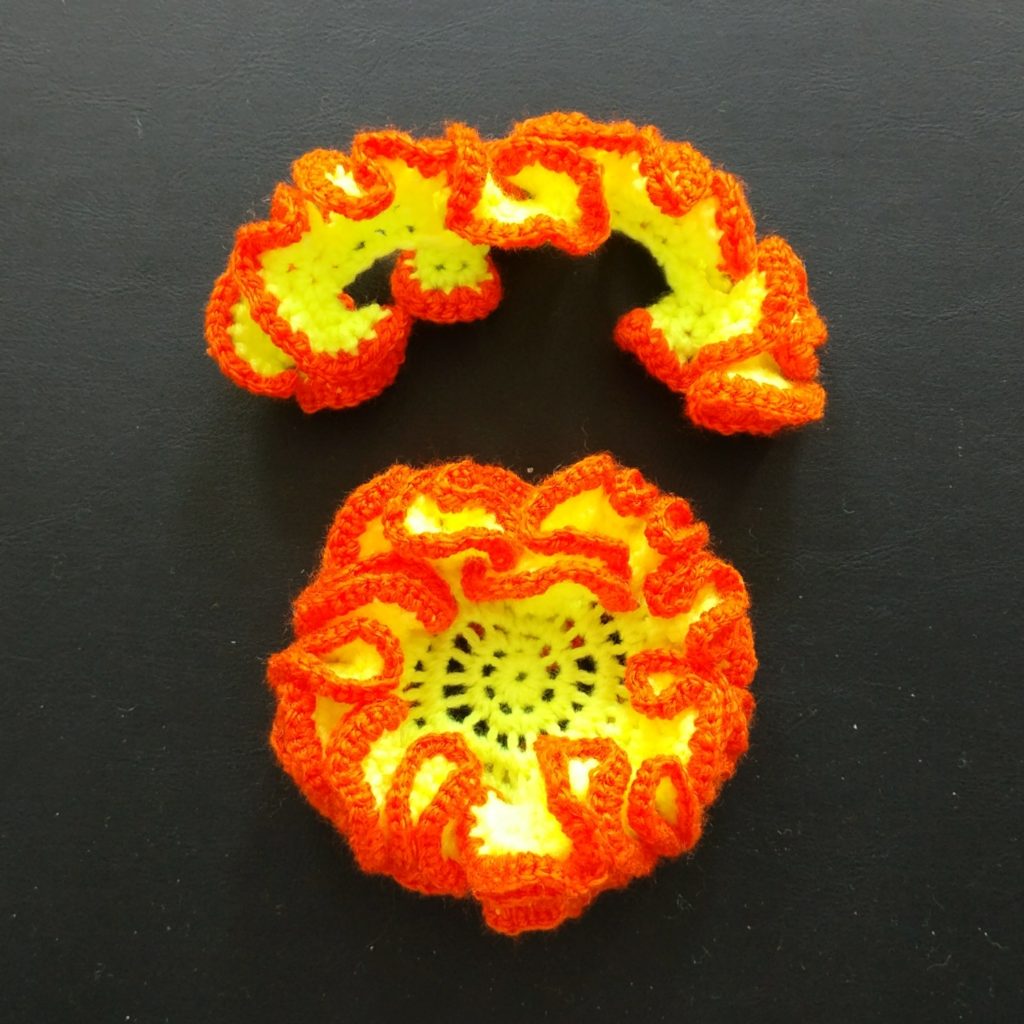A few months ago I made some ‘Squiggly Things’. They don’t have a proper name but they are a form of hyperbolic crochet and great fun to make. They are nice toys for children or for stress-relief. They are very tactile and can be twisted and turned without getting damaged.
This week someone asked me a question that made me go back and look at them again. (See below)
My squiggles were colour-coded. The first were made with orange edges. Every stitch is increased to make two stitches. Some were started with chains, some with circles. Adding more rows of crochet makes the shapes curl and become more densely packed.


The question that was asked was ‘How do you work out the area of a squiggle?’ We assumed that this meant what would the area be if you could measure the surface of one side of all the twists in the squiggle.
Interestingly, after the first few rounds of crochet, the overall shape of a round squiggle doesn’t change much. The ‘ball’ just become more and more tightly packed but there is clearly much more surface inside.
The best attempt at calculating the area can only be an approximation as there are strange factors to be taken into account. It is easy to work out the number of stitches. If the squiggle begins with 6 stitches and an increase is made in each stitch, the number of stitches doubles on each round.
- Round 1 = 6 stitches
- Round 2 = 12 stitches. Total = 6 + 12 = 18
- Round 3 = 24 stitches. Total = 6 + 12 + 24 = 42
- Round 4 = 48 stitches. Total = 6 + 12 + 24 + 48 = 90
- Round 5 = 96 stitches. Total = 6 + 12 + 24 + 48 + 96 = 186
- Round 6 = 192 stitches. Total = 6 + 12 + 24 + 48 + 96 + 192 = 378
If you know the area of each stitch you can then calculate the total area worked so far.
Or can you?
All of the stitches are worked into the top of existing stitches but what happens to the tops of the stitches on the top row? Do the stitches on the top row have a greater area than the rest because they are not sharing any space with other stitches?
Wool is squashy. The bottoms of the stitches are squashed together and the tops are more spread out. Does this mean they have more volume but no more area? Does volume matter at all if we are calculating the surface area?
I don’t think there can be an accurate answer to the question.
After pondering these questions, I moved on to thinking about the squiggles I made with different rates of increase. When I made them I was very surprised by how a seemingly small change made a dramatic difference. Then we made a video to try to show what happens. The three-section squiggle shows the changes and the table shows the maths behind it.
My favourite squiggles are the rainbows in this video
I made lots of squiggles. In my Ravelry projects you can see photos and find information such as the amount of yarn needed for each:
1 2 3 4 5 6
If you want to know about the maths of hyperbolic crochet, look up the work of Daina Taimina. She is the expert.
The problem of calculating the area is closely related to the Coastline Paradox and the Wheat and Chessboard Problem.
The maths makes my head hurt but I love the crochet! I was telling my Mathsy son about these last week; I must crochet him a hyperbolic ball (or several as he juggles).
They are not heavy enough for juggling – but we do have Grime Dice juggling balls https://www.ravelry.com/patterns/library/grime-dice-juggling-balls (I think I might need to post about those now because there is a nice video)